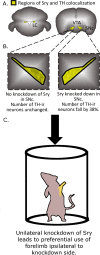The genetics of sex differences in brain and behavior
- PMID: 20951723
- PMCID: PMC3030621
- DOI: 10.1016/j.yfrne.2010.10.001
The genetics of sex differences in brain and behavior
Abstract
Biological differences between men and women contribute to many sex-specific illnesses and disorders. Historically, it was argued that such differences were largely, if not exclusively, due to gonadal hormone secretions. However, emerging research has shown that some differences are mediated by mechanisms other than the action of these hormone secretions and in particular by products of genes located on the X and Y chromosomes, which we refer to as direct genetic effects. This paper reviews the evidence for direct genetic effects in behavioral and brain sex differences. We highlight the 'four core genotypes' model and sex differences in the midbrain dopaminergic system, specifically focusing on the role of Sry. We also discuss novel research being done on unique populations including people attracted to the same sex and people with a cross-gender identity. As science continues to advance our understanding of biological sex differences, a new field is emerging that is aimed at better addressing the needs of both sexes: gender-based biology and medicine. Ultimately, the study of the biological basis for sex differences will improve healthcare for both men and women.
Copyright © 2010 Elsevier Inc. All rights reserved.
Figures




References
-
- Levant RF, Hall RJ, Williams CM, Hasan NT. Gender Differences in Alexithymia. Psychol Men Masc. 2009;10:190–203.
-
- Addis ME, Mansfield AK, Syzdek MR. Is “Masculinity” a Problem?: Framing the Effects of Gendered Social Learning in Men. Psychology of Men & Masculinity. 2010;11:77–90.
-
- Woody S, McLean PD, Taylor S, Koch WJ. Treatment of major depression in the context of panic disorder. J Affect Disord. 1999;53:163–74. - PubMed
-
- Greenough WT, Carter CS, Steerman C, DeVoogd TJ. Sex differences in dentritic patterns in hamster preoptic area. Brain Res. 1977;126:63–72. - PubMed
Publication types
MeSH terms
Substances
Grants and funding
LinkOut - more resources
Full Text Sources
Research Materials

